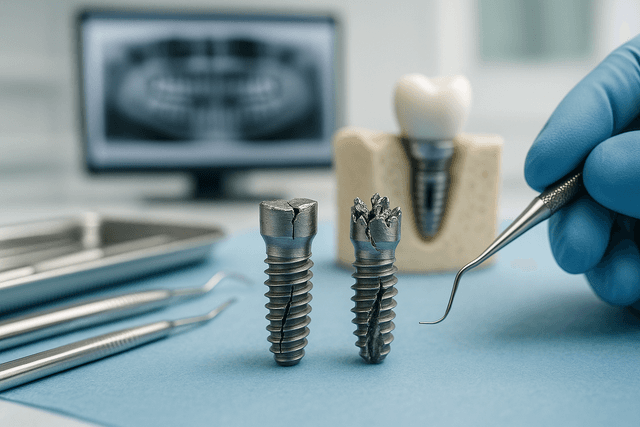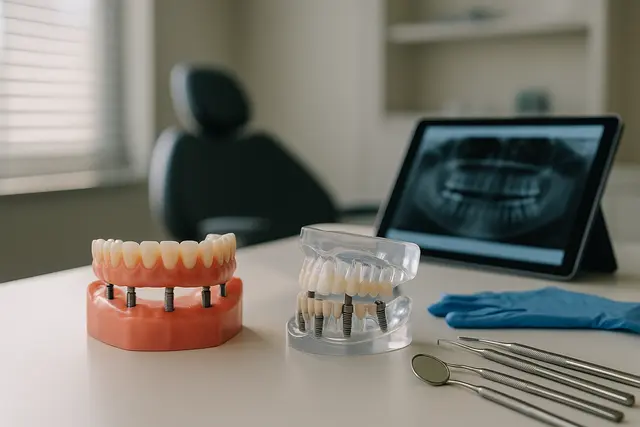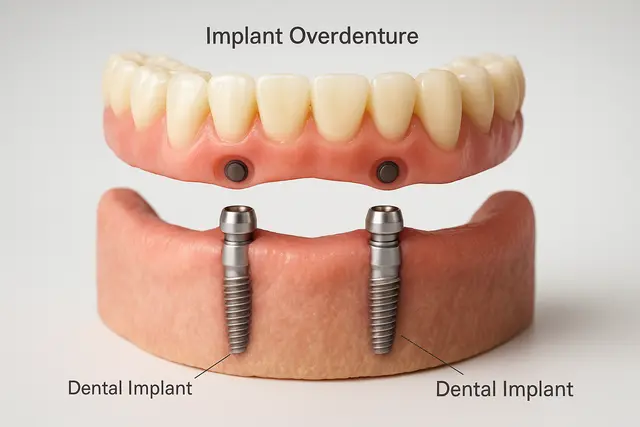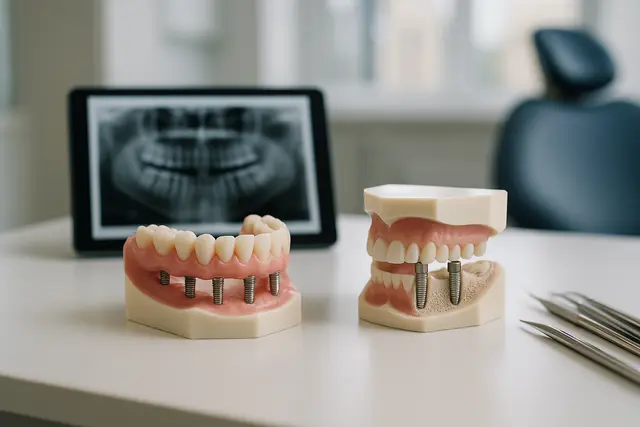Prosthodontics
5 min read
Oct 09, 2025
Dental Implant Screw Fracture: What It Means and Next Steps to Take
Dental implants are designed to be durable and reliable, but like any mechanical system, they’re not immune to complications. One of the most frustrating issues patients may face is a fractured implant screw. While it can feel alarming in the moment, understanding what it means and how it’s managed can make the situation far less daunting.

When the Screw Breaks: Understanding What Just Happened
You’re biting into your favorite sandwich, and then, crunch. But not the satisfying crunch of lettuce. Something doesn’t feel right. That tiny piece of metal you’re suddenly aware of? Yep, that might be a broken screw from your dental implant.
Sounds terrifying, but take a breath. Let’s walk through it together.
The screw plays a critical role in your dental implant. It’s the small but mighty connector that anchors the abutment (the part that holds your crown) to the implant body (which sits inside your jawbone). When a screw fracture occurs, it’s like the silent engine under the hood suddenly quitting. You may not see it, but everything relies on it.
Screw fractures can range from mildly annoying to genuinely disruptive. Understanding why the fracture occurred and how to fix it without damaging the implant is key. So let’s get into the nuts and bolts (literally).
What Is a Dental Implant Screw Fracture?
A dental implant screw fracture happens when the implant screw, usually made of strong titanium, snaps or breaks under pressure. It’s not the most common implant complication, but it’s also not exactly rare.
And here’s the kicker: implant screws are made to withstand a lot, but they’re not indestructible. Like any small screw under constant stress, especially uneven pressure on the screw from a misaligned bite or poorly distributed force, something’s gotta give eventually.
The fracture might occur suddenly, or it may build over time with tiny micro-movements weakening the structure. Either way, when the screw breaks, it’s time to act.
Causes of Implant Screw Fracture and Other Implant Complications
There’s no single cause. But the usual suspects include:
Screw loosening and fracture over time, especially if proper screw tightening wasn’t done at the start
Poor implant placement, leading to an angle that creates excess pressure on one side
Implant and prosthetic misfit, meaning the crown doesn’t sit flush with the abutment
The use of dental prostheses with cantilever extensions, which adds torque stress
Biting forces, especially if you grind your teeth at night or eat jaw-busting foods
Fatigue in the screw head over time due to repetitive load cycles
Manufacturing inconsistencies (rare but possible), since not all screws are made exactly the same
The incidence of screw fracture is higher in cases with off-axis loading or when supporting a single implant crown in a high-load area like the molars. If you’ve had multiple loose screws over time, consider that a red flag.
Signs You Might Have a Fractured Implant Screw
Not every fracture is dramatic. Sometimes, it’s subtle. But here’s what to watch for:
Sudden mobility of the implant crown
Feeling like your bite is off
Pain or discomfort around the implant
A gap between the crown and gumline
Clicking or grinding sounds when you chew
The crown literally falling off (yep, it happens)
If the screw has broken, your dentist might confirm it after removing the implant crown and seeing the portion of the broken screw lodged inside the implant.
How Screw Removal Works Without Damaging the Implant
Screw removal is an art and a science. Your dentist will aim to:
Identify the coronal portion of the fractured screw
Use specialized screw retrieval kits or tools
Sometimes create a groove on the screw fragment to engage the screw with an excavator to engage the fractured area
All of this is done without damaging the implant or its internal threads. A gentle hand and experience matter here. If the screw fragment is stuck too deep or the threads are stripped, implant removal might be the only option, but that’s a last resort.
What Happens If the Broken Screw Can’t Be Removed
If the broken screw fragment refuses to budge or the internal threads are too damaged to place a new screw, there are a few options:
Remove the implant and place a fresh one later
Use a custom abutment if possible
Leave the implant and avoid using it functionally (not ideal, but possible)
Either way, management of fractured implant abutment screws depends on how deep the damage runs. Some cases require surgical intervention, while others can be handled chairside in your regular dental office.
Fixing a Broken Implant Screw and Getting a New Implant Crown
Let’s say you’re lucky. The fractured implant screw was retrieved cleanly, and the implant structure looks fine. You’ll probably need:
A new screw
Possibly a new abutment
A freshly designed implant crown
In some cases, the removal of the fractured screw is followed by cleaning and evaluating the implant system for integrity. If everything checks out, a new screw and crown can be placed fairly quickly.
But if there’s been damage to the implant body or threads, you might face a longer road that includes removal of the fractured implant, healing, and implant placement again later.
The Management of Fractured Implant Screws: What Dentists Really Do
This is where the management of fractured screws gets technical. Dentists use tools and tactics like:
Microsurgical techniques
Reverse torque drivers
Ultrasonic tips to vibrate the screw fragment loose
Kits designed for the retrieving fractured implant screws
Creative use of an excavator to engage the fractured piece and reverse it out
If the fractured implant is intact, you’re in luck. If not, expect more comprehensive management of implant solutions.
Prevention Tips So It Doesn’t Happen Again
A fractured screw isn’t always avoidable, but your chances drop dramatically with the right care. Here’s how:
Make sure your dentist uses high-quality implant systems.
Always get regular maintenance checks.
Mention if you clench or grind your teeth.
Don’t ignore signs of screw loosening.
Avoid chewing ice or hard nuts on implant crowns.
Replace worn abutments or implant crowns as needed.
Regular checkups allow early detection of screw loosening and screw fractures, letting your provider intervene before a full fracture of dental implants happens.
What Is a Dental Implant Screw Fracture?
A dental implant screw fracture happens when the small titanium screw that connects the implant abutment to the implant body snaps under stress. This screw is designed to be strong, but years of repeated pressure, misaligned bites, or improper tightening can cause it to weaken and break. While not the most common implant complication, it can disrupt the stability of the crown and the implant as a whole.
What Causes a Dental Implant Screw to Break?
Screw fractures can result from multiple factors, including uneven bite forces, teeth grinding (bruxism), poor implant placement, or fatigue from repeated chewing cycles. In some cases, poorly fitted crowns or prosthetic misalignment add extra torque to the screw. Even though screws are made from durable titanium, long-term stress, especially in high-bite areas like molars, increases the risk of fracture.
What Are the Signs of a Broken Implant Screw?
The symptoms of a fractured screw may be subtle or obvious. Common signs include looseness in the crown, pain or swelling around the implant, a clicking sound when chewing, or visible gaps between the crown and gumline. In severe cases, the crown may detach completely. Dentists often confirm the issue by removing the crown to check for a fractured screw lodged inside the implant body.
How Is a Broken Implant Screw Fixed?
Treatment depends on how the screw fractured. Dentists typically use specialized retrieval tools to carefully remove the screw fragment without damaging the implant threads. If successful, a new screw and crown can be placed. If the fragment is stuck or the implant body is damaged, more advanced solutions may be required, such as replacing the implant or creating a custom abutment. Regular checkups and using protective measures like night guards help reduce the risk of future fractures.
Read Next
Related Posts

Prosthodontics
Implant Supported Dentures Overview
Missing teeth can impact more than just your smile, they can affect your confidence, comfort, and even your diet. Fortunately, modern dentistry offers a solution that’s both secure and natural-looking: implant-supported dentures. This innovative approach blends the stability of implants with the convenience of dentures to create a long-lasting, life-improving upgrade.
5 min read
Oct 29, 2025

Prosthodontics
Implant Overdentures Explained: The Hybrid Solution to Missing Teeth
Missing teeth can impact everything from your ability to eat to your self-confidence. While traditional dentures have long been a go-to solution, they often fall short in comfort and stability. Implant overdentures offer a modern alternative that combines the security of dental implants with the convenience of removable dentures, a true upgrade for those looking to reclaim their smile.
6 min read
Oct 29, 2025

Prosthodontics
Implant Retained Dentures Explained
Considering implant-retained dentures? You're not alone. As modern dentistry evolves, more people are turning to this secure, natural-feeling alternative to traditional dentures. This guide will walk you through what they are, how they work, and why they might be the solution you've been looking for.
4 min read
Oct 28, 2025
Don’t have time to research every dentist around you?
See why 30k+ patients trusted us